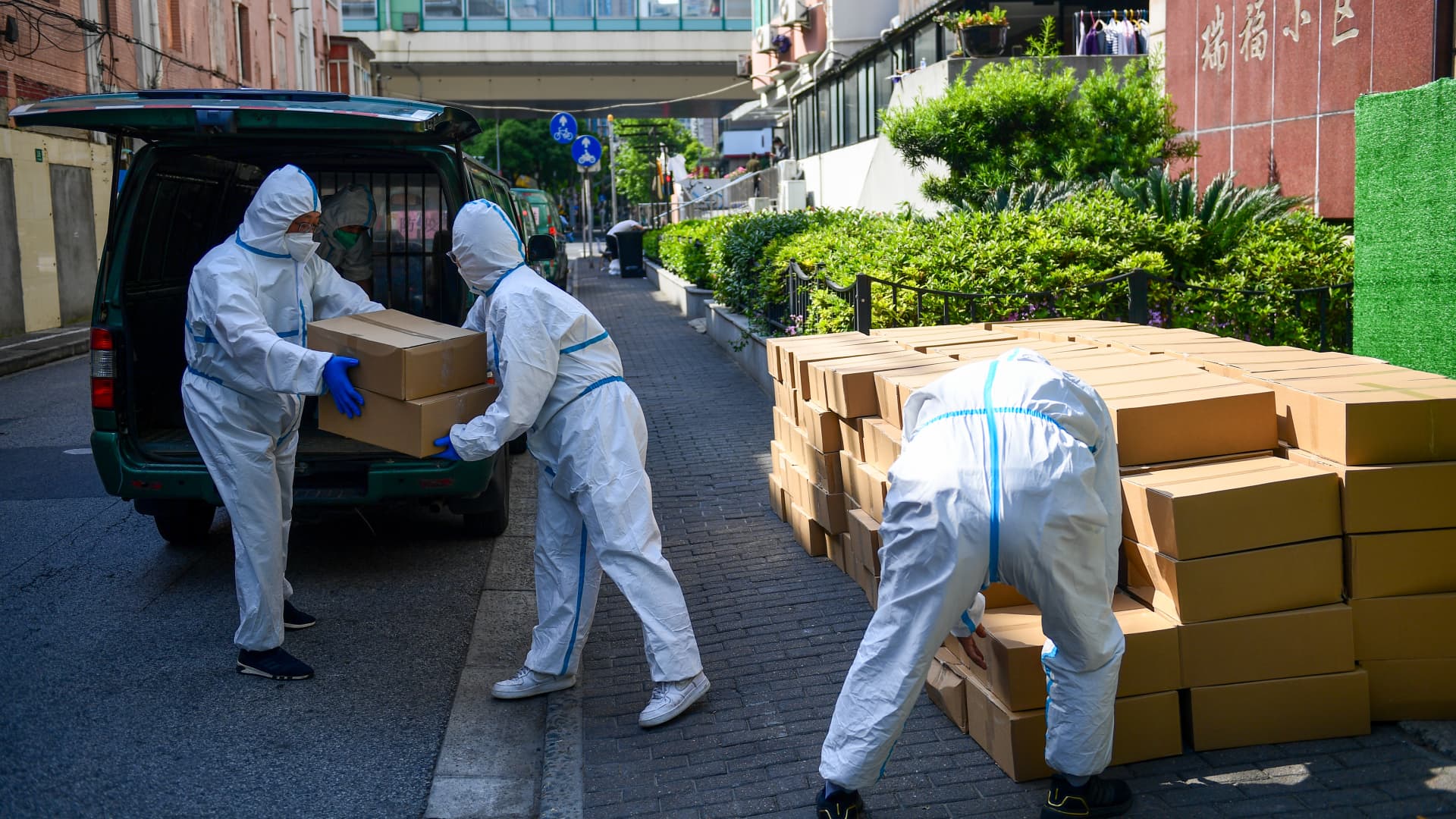Latest Shanghai quarantines add more pressure to global supply chain
Staff members of China Post unload parcels of daily necessities for residents quarantined at home from a minivan on May 14, 2022 in Shanghai, China.
Tian Yuhao | China News Service | Getty Images
The mass quarantine measures imposed this past weekend in Shanghai, including highway closures, severely affected trucks carrying exports bound for the city’s port, according to logistics company Orient Star Group.
“Trucks loaded with cargoes and containers were unable to enter the Shanghai terminal,” said the company, which also contributes to CNBC’s Supply Chain Heat Map. The heat map is a new data tool that CNBC created with 13 of the world’s top maritime and logistics data providers to give investors better insight into inventory flows in real time.
“Many clients have no choice but to change the loading ports to Ningbo or other small ports along the Yangtze River.”
The Port of Ningbo, which became the alternative port destination, is now showing an increase in congestion since Covid cases keep showing up in certain Shanghai districts.
“Production and manufacturing are basically resumed in Shanghai, but once there are quarantines, transportation and drayage are affected to a certain extent,” Orient Star Group said.
DHL Global Forwarding tells CNBC finding truckers in and out of the Shanghai area still presents a challenge.
During the lockdown, the slowdown in trucking led to raw material shortages for companies such as Volkswagen and Tesla. Before the latest restrictions, truck drivers were still required to provide a nationally recognized 48-hour negative Covid test result and traffic permit, said Akil Nair, Seko Logistics’ vice president of global carrier management and ocean strategy for Asia-Pacific. In practice, he said many local governments have also demanded that tests be retaken locally and on highways.
“Some drivers are cautious about delivering into Shanghai and capacity has yet to fully recover to pre-lockdown volumes,” he said.
The latest quarantine restrictions come at a time when trucking capacity recovered to around 80%.
Orient Star Group is also seeing a pickup in West Coast cargo, which had been trending down. This is a forward-looking indicator of the container uptick many logistics experts were predicting. Containers bound for the East Coast remain strong and stable.
People in 15 of Shanghai’s 16 districts this weekend were ordered to be tested for the fast-spreading omicron variant. Five districts barred residents from leaving their homes.
The districts include Pudong, home to Tesla’s gigafactory, Merck, Covestro, L’Oreal, Thermo Fisher, SC Johnson, Siemens, Bosch, SAIC-GM and Advanced Micro-Fabrication Equipment; and the specialty chemical manufacturing district of Xuhui. Apple, Sony, and Volkswagen have all said Shanghai’s “zero Covid” restrictions have impacted the supply of materials needed to make their products.
The district of Jing’an is home to many semiconductor and electronics manufacturers.
U.S. ports feel the pinch
The increase in West Coast cargo comes at a time when ports in the West are slowly processing import containers due to a lack of rail options and trucks being used as makeshift warehouses.
Congestion at the ports of Los Angeles and Long Beach, California, has affected the Port of Oakland, California, which has been skipped by the ocean carriers that are looking to make up time on their schedules. This is having an impact on the amount of U.S. export containers leaving the port. Logistics managers are also trying to regain some control by moving more containers to the East Coast and Gulf Coast. Now those ports are getting clogged up, too.
“Congestion measured in the number of waiting cargo vessels outside major ports is now worse on the East and Gulf coasts than on the West Coast, a major shift compared to the start of 2022,” said Mirko Woitzik, director of intelligence solutions at Everstream Analytics.
To keep up with growing container volume, the Port of Houston recently announced gate hours on Saturdays for the rest of the year. Warehouses at the Port of Savannah, Georgia, are 99% full and are using their pop-up container storage lots to free up land capacity.
“2022 is showing us that East Coast ports are just as susceptible to congestion,” said Brian Bourke, chief growth officer of Project44.
Europe labor strife
Last week, a union of port operators in Germany followed through on its “warning strike” that disrupted one of the afternoon shifts at the ports of Emden, Bremen, Bremerhaven and Wilhelmshaven.
Negotiations continue between the union ver.di, which represents about 70% of the port workforce, and the Central Association of German Seaport Companies.
The system is already under strain and any loss of manpower will only add to the congestion, said Andreas Braun, ocean product director EMEA at Crane Worldwide Logistics.
“Feeder operators see up to five days of delays waiting for berth to pick up their containers, and round trips between Rotterdam – Dublin – Rotterdam has increased from six to nine days. More vessels need to be injected by the feeder operators to keep the schedule somehow reliable,” Braun said. Rotterdam is in the Netherlands.
The Port of Hamburg in Germany, Europe’s third-largest container port and the largest railway port, is crucial for autos. BMW, Rolls Royce, Volkswagen, Michelin and Ford export products ranging from fully assembled automobiles to parts and lithium batteries. Other major exporters include Ikea, BASF, Siemens and Bayer.
The CNBC Supply Chain Heat Map data providers are artificial intelligence and predictive analytics company Everstream Analytics; global freight booking platform Freightos, creator of the Freightos Baltic Dry Index; logistics provider OL USA; supply chain intelligence platform FreightWaves; supply chain platform Blume Global; third-party logistics provider Orient Star Group; marine analytics firm MarineTraffic; maritime visibility data company Project44; maritime transport data company MDS Transmodal UK; ocean and air freight benchmarking analytics firm Xeneta; leading provider of research and analysis Sea-Intelligence ApS; Crane Worldwide Logistics; and air, DHL Global Forwarding, and freight logistics provider Seko Logistics.
— CNBC’s Gabriel Cortes contributed to this article.
For all the latest Technology News Click Here

